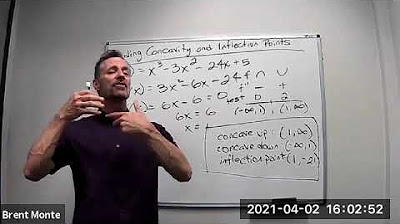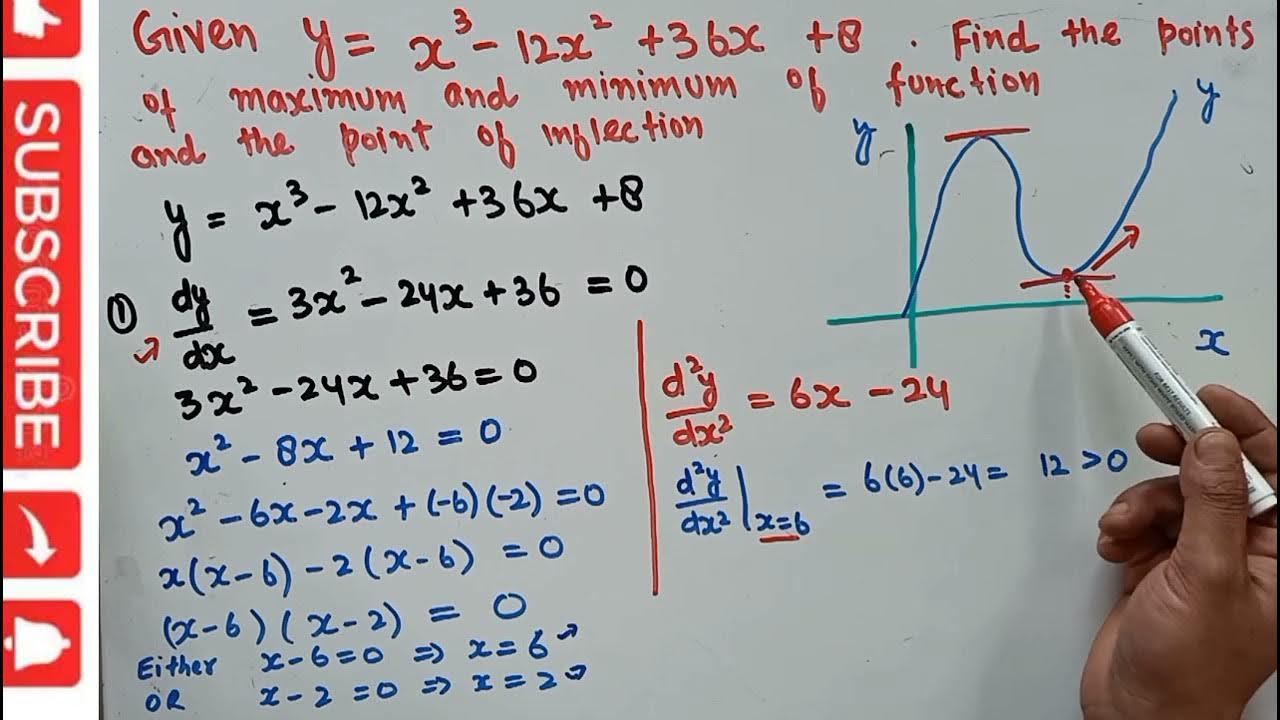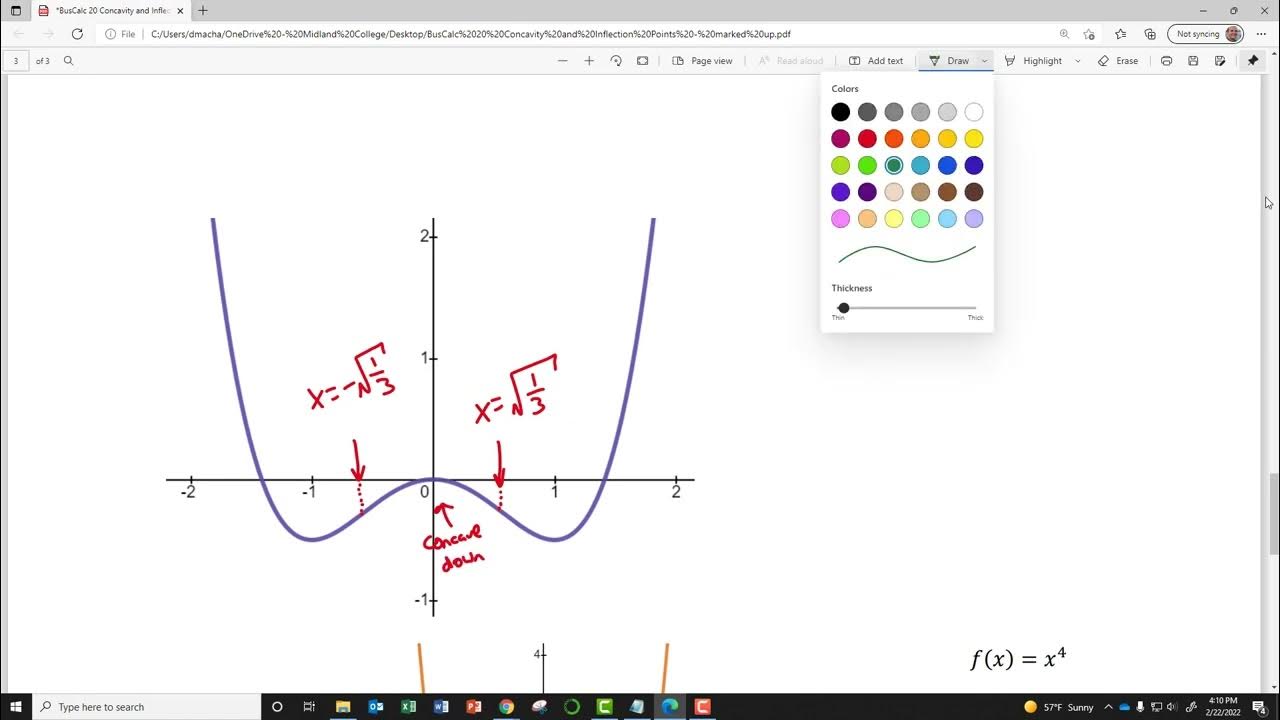How to Find Inflection Points
TLDRThis instructional video teaches viewers how to identify inflection points in a function, which are points where the concavity changes from concave up to down or vice versa. The presenter demonstrates the process using a specific function, f(x) = 3x^5 - 30x^4. The method involves finding the second derivative, setting it to zero, and solving for x to find potential inflection points. The video guides through checking the concavity on either side of the critical points to confirm if they are true inflection points. The example concludes with identifying x = 6 as an inflection point and calculating the corresponding y-value, resulting in the point (6, -15,552). The video concludes with a review of the steps and encourages viewers to subscribe for more educational content.
Takeaways
- 📚 Inflection points are where a function changes concavity from concave up to concave down or vice versa.
- 🔍 To find inflection points, first understand the concept of concavity and how it relates to the function's shape.
- 📈 The process involves finding the second derivative of the function, which indicates changes in concavity.
- 📝 For the given example, the function is f(x) = 3x^5 - 30x^4, and the task is to find its inflection points.
- 🔑 The first step is to calculate the first derivative of the function, resulting in 15x^4 for the first term and 120x^3 for the second.
- 🔍 Next, find the second derivative by differentiating the first derivative, yielding 60x^3 and -360x^2.
- 🧩 Set the second derivative equal to zero to find possible x-values for inflection points: 60x^3 - 360x^2 = 0.
- 🔢 Factor out common terms to simplify the equation, which in this case is 60x^2, leading to x(x - 6) = 0.
- 📍 Solve for x to find potential inflection points at x = 0 and x = 6.
- 📊 Plot these x-values on a number line and check the concavity on either side to determine if there's a switch from concave up to concave down or vice versa.
- 🔎 For x = 0, the function is concave down on both sides, so it's not an inflection point. For x = 6, it switches from concave down to concave up, confirming it as an inflection point.
- ✅ The final step is to find the exact coordinates of the inflection point by substituting x = 6 back into the original function, resulting in the point (6, -15,552).
Q & A
What is an inflection point in the context of a function?
-An inflection point is a point on the graph of a function where the function changes its concavity from concave up to concave down or vice versa.
How can you determine if a point is an inflection point?
-To determine if a point is an inflection point, you need to check if the function changes its concavity from concave up to concave down or vice versa around that point.
What is the first step in finding inflection points of a function?
-The first step in finding inflection points is to find the second derivative of the function.
Why is the second derivative important in finding inflection points?
-The second derivative is important because it helps determine the concavity of the function. A change in the sign of the second derivative indicates a change in concavity, which could be an inflection point.
What is the function given in the video script as an example?
-The function given in the video script as an example is f(x) = 3x^5 - 30x^4.
How do you find the first derivative of the given function in the script?
-To find the first derivative of the function f(x) = 3x^5 - 30x^4, you differentiate each term: the derivative of 3x^5 is 15x^4, and the derivative of -30x^4 is -120x^3.
What is the second derivative of the function f(x) = 3x^5 - 30x^4?
-The second derivative is found by differentiating the first derivative. So, the derivative of 15x^4 is 60x^3, and the derivative of -120x^3 is -360x^2.
How do you set up the equation to find the possible inflection points?
-To find the possible inflection points, you set the second derivative equal to zero and solve for x: 60x^3 - 360x^2 = 0.
What values of x make the second derivative equal to zero in the given example?
-In the given example, the values of x that make the second derivative equal to zero are x = 0 and x = 6.
How do you determine if x = 0 is an inflection point for the given function?
-To determine if x = 0 is an inflection point, you check the concavity on both sides of x = 0. If the concavity changes from concave up to concave down or vice versa, then x = 0 is an inflection point. In the script, it is shown that x = 0 is not an inflection point because the concavity does not change.
What is the final step to confirm an inflection point and find its coordinates?
-The final step to confirm an inflection point and find its coordinates is to plug the x-value (where the second derivative is zero and concavity changes) back into the original function to find the corresponding y-value.
What is the point of inflection for the function given in the video script?
-The point of inflection for the function f(x) = 3x^5 - 30x^4 is at x = 6, with a y-value of -15,552, which is found by substituting x = 6 back into the original function.
Outlines
📚 Understanding Inflection Points and Their Calculation
This paragraph introduces the concept of inflection points in calculus, which are points on a graph where a function changes its concavity from concave up to concave down or vice versa. The video aims to demonstrate how to find these points using a specific function as an example. The function given is f(x) = 3x^5 - 30x^4. The process begins by finding the first and second derivatives of the function. The first derivative is calculated to be 15x^4, and the second derivative results in 60x^3 - 360x^2. The next step is to set the second derivative equal to zero to solve for possible inflection points, which yields x = 0 and x = 6 after factoring and simplifying the equation 60x^3 - 360x^2 = 0.
📉 Analyzing Concavity to Confirm Inflection Points
The second paragraph continues the process of identifying inflection points by analyzing the concavity around the potential points found by setting the second derivative to zero. The values x = 0 and x = 6 are tested to determine the concavity on either side of these points. For x = 0, the concavity is checked by evaluating the second derivative at x = -1, which results in a negative value, indicating concave down. The same is done for x = 6 by evaluating the second derivative at x = 10, yielding a positive value, indicating concave up. This change from concave down to concave up confirms that x = 6 is indeed an inflection point. The paragraph concludes by calculating the actual point of inflection in the coordinate plane by substituting x = 6 back into the original function, resulting in the point (6, -15,552). The video ends with a summary of the steps to find an inflection point and an invitation to subscribe for more educational content.
Mindmap
Keywords
💡Inflection Point
💡Concave Up
💡Concave Down
💡Second Derivative
💡Derivative
💡Function
💡Graph
💡Concavity
💡Factor
💡Plot
Highlights
Introduction to the concept of inflection points in a function.
Explanation of inflection point as a switch from concave up to concave down or vice versa.
Visual representation of an inflection point on a graph.
Example function given: f(x) = 3x^5 - 30x^4.
Step-by-step process to find inflection points by finding the second derivative.
Derivation of the first derivative: 15x^4 for the given function.
Derivation of the second derivative: 60x^3 - 360x^2.
Setting the second derivative equal to zero to find possible inflection points.
Factoring out 60x^2 from the second derivative equation.
Solving for x to find the values that make the second derivative zero: x = 0 and x = 6.
Plotting the potential inflection points on a number line.
Checking concavity by evaluating the second derivative for values less than and greater than potential inflection points.
Determining that x = 0 is not an inflection point as it does not switch concavity.
Finding that x = 6 is an inflection point as it switches from concave down to concave up.
Calculating the y-value of the inflection point at x = 6.
Final inflection point coordinates: (6, -15,552).
Review of the method to find inflection points including finding the second derivative, solving for x, and checking concavity.
Conclusion and call to action to subscribe for more educational content.
Transcripts
Browse More Related Video

Finding Concavity and Inflection Points

Points of inflection from the graphs of f, f' or f''

Point of Inflection - Point of Inflexion - f''(x)=0 - Definition - How to Find - Worked Example 1

Maxima , minima and point of inflection

Learn how to determine concavity and point of inflection AP style

BusCalc 20 Concavity and Inflection Points
5.0 / 5 (0 votes)
Thanks for rating: